Acclaimed jazz artist, Nils Landgren, first started to support Medecins Sans Frontieres (MSF) in 1994, when he took part in a charity concert in support of the organisation’s work in Rwanda. Since then, his collaboration with MSF has grown, with Nils and his band forming the initiative, Funk for Life, which raises money for MSF through album sales and aims to inspire achievement in children through music.
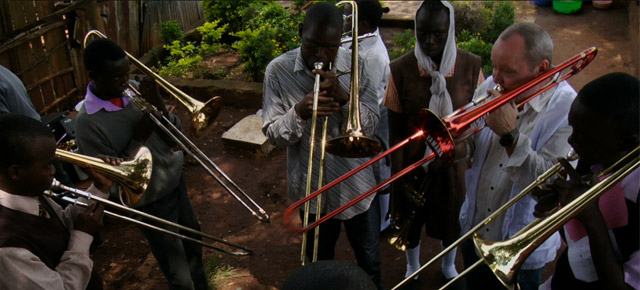
Nils and his band, The Nils Landgren Funk Unit, first travelled to Kibera, which is one of Africa’s largest slums, in 2009. As well as donating musical instruments and teaching children how to play, the band performed at the opening ceremony for a new MSF clinic in the Kenyan slum. They have maintained a link with the community since then, and will return again later this month to perform at a concert timed to coincide with the handover of the clinic from MSF to the Nairobi City County Health Services.
“I first got involved with MSF more than twenty years ago, but the collaboration really took off when me and the guys in my band, the Nils Landgren Funk Unit, organized a concert to support the 15th anniversary of MSF in Sweden. We all admired the work that MSF was doing, but we’re not doctors or nurses, so we wanted to try to contribute through our music. So, we put on a concert, and all of the money from the ticket sales went to MSF.
The experience made us want to take the collaboration further, beyond just raising money, and after many long discussions we came up with the idea of starting a music project for kids. I hoped we could encourage young kids to move forward through music. Not only is music a means of communication, I think it has an incredible capacity to show people what they can achieve, through something as simple as holding an instrument.
Together with the members in my band, I set up a charity initiative called Funk for Life. As well as raising money specifically for a new clinic that MSF was building in Kibera, we would give musical instruments to children in the local community and teach them how to play.
Going to Kibera for the first time was a totally overwhelming experience; none of us had been in such a different environment before. There was almost no water, electricity or sanitary facilities. At the same time, in the middle of all of this poverty and misery, we saw proud people who were doing the best with what they had. Whatever difficulties people were coping with they had pride and dignity. This was a real lesson for us.
Visiting MSF’s clinics was also a real eye opener; the facilities were simple, but even in those conditions, the doctors and nurses really could do wonders.
I was unsure how interested the children would be in the musical instruments. In one of our first days I noticed a group of children who could not take their eyes off my trombone. I asked if they wanted to play it, but they were all too shy. I could see that one girl in particular was interested, but she did not dare. When she finally picked up the trombone she managed to get a sound out of it. After that, they all wanted a go. The children went from not wanting to touch the instruments, to not wanting to put them down.
As it turned out, there were a lot of kids in Kibera who were very interested in trying to understand how instruments worked. We also recorded some of the children singing, which featured on the title track of our album, “Funk for Life”, that raised money for MSF.
The second time I went to Kibera, we were doing an instrument presentation to children from seven schools under a big tree. We soon started playing together; even people who have never held an instrument before can usually start to play something in a relatively short time.
Whilst we were playing, a small girl handed me a note. It said that she wanted to go to school. A little later, I saw her sitting on the red earth, looking really gloomy, with a shiny silver flute in her hand. I asked her what was wrong, and she explained that she had been told off for asking me for help. I said that I would see what was possible. I spoke to the teachers and arranged to pay for her to go to school.
I have a very strong memory of this girl, who I now know to be called Juliet, so I really hope that I will see her again. From what I know she is still at school and is getting good grades. Perhaps she is still playing the flute.
This next trip to Kibera will be the third time we have visited. As well as the charity, we also support a local school, Wings for Life, to provide food for their students, and we have put a number of other children, like Juliet, through higher education. Our project has also expanded outside of Kibera, and we have replicated it in Khayelitsha, South Africa.
What has stayed with me over the years that I have been involved in this project is the power of people living in places like Kibera, and we are honoured to be going back to see some of them again, and to celebrate the successful handover of the MSF clinic to the Nairobi City County Health Services. Kibera has a big place in my heart, and in the hearts of everyone who is involved with this project, and that is something that we hope to keep.
——————————————————-
For 2014, The Funk For Life Project ambition is to support Music Programme called “Magnet Music Schools” in Soweto (South West Township) of Johannesburg.
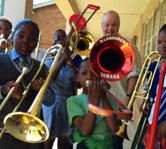
Soweto
As for Khayelitsha last year, the project will aim to raise awareness about life in the township of Soweto, Johannesburg whose most population is living in precarious situation.
On top of the music instruments distribution & music workshop in Thaba-Jabula Secondary School in Klipspruit, Soweto (part of the Magnet Music Programme), Funk For Life Project in South Africa will comprised of a video recorded in Johannesburg with Nils Landgren Funk Unit & Concord Nkabinde and a series of short clips composed of interviews, discussions and stories from the township inhabitants, the Funk Unit artists & Concord Nkabinde themselves.
Set against a wide selection of footage shot inside Soweto, the music video and short clips portray the objectives of the Funk For Life Project, with recording performance by Nils Landgren and his Funk Unit & Concord Nkabinde in SA as their presence in the township as they teach kids how to play their instruments.
Soweto (South West Township of Johannesburg)
Soweto is a large township with over 1,3 million inhabitants located on the outskirts of Johannesburg.
Many parts of Soweto rank among the poorest in Johannesburg, although individual townships tend to have a mix of wealthier and poorer residents. In general, households in the outlying areas to the northwest and southeast have lower incomes, while those in southwestern areas tend to have higher incomes.
The economic development of Soweto was severely curtailed by the apartheid state, which provided very limited infrastructure and prevented residents from creating their own businesses. Roads remained unpaved, and many residents had to share one tap between four houses, for example. Soweto was meant to exist only as a dormitory town for black Africans who worked in white houses, factories, and industries.
In 1994 Sowetans earned on average almost six and a half times less than their counterparts in wealthier areas of Johannesburg (1994 estimates). Some Sowetans remain impoverished, and others live in shanty towns with little or no services. About 85% of Kliptown comprises informal housing.
——————————————————-
Funk For Life moves to Khayelitsha, South Africa!
In April 2013, after 3 consecutive years supporting the work of MSF in Kibera – Kenya, the Funk For Life project has for ambition now to support as well the work of MSF in Khayelitsha, South Africa (SA).
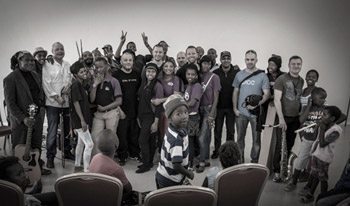
Funk For Life in Khayelitsha, South Africa!
Funk For Life in SA will aim to portray life in the township of Khayelistha, Cape Town whose most population is living in very precarious situation without clean water, electricity, sanitation, education or healthcare.
On top of the music instrument distribution & music workshop in the music schools in Khayelitsha, Funk For Life Project in South Africa will comprised a series of short clips composed of interviews, discussions and stories from the township inhabitants and Docotrs without Borders (MSF) patients, the Funk Unit artists & Lira themselves and of course aid workers from Doctors Without Borders (MSF) and their endless efforts to fight the HIV/AIDS & TB epidemics inside the township.
The video clips will not only show the tremendously difficult living conditions in Khayelitsha and the work of MSF, but will go beyond Nils and Lira’s public persona to their private life as humanists and their respective quest for “Music for Change”.
Khayelitsha…
Khayelitsha is a large township with over 500,000 inhabitants located on the outskirts of Cape Town. The majority of the population originates from regions outside Western Cape Province: only an estimated 5% of the population is born in Khayelitsha, and an estimated 75% of the people come from Eastern Cape, come in the hope to find a job and increase the quality of their life.
Thirty percent of the population are children under the age of 14, and 46% of the total population is between 15 and 34. The ratio men: women is approximately 50:50. Over 70% of the population are living in informal housing (shacks), with the remaining one-third lives in brick houses.
The literacy rate (defined as able to read a newspaper in isiXhosa, the most commonly spoken language in Khayelitsha) is high, at about 94%. More boys than girls attend primary school. Overall, 70% of the people have obtained their Junior Certificate (obligatory schooling certificate at the end of Grade 9) and an estimated 25% of the population has graduated from high school. There is no gender difference in high school graduation. Although the percentage of the people going on to tertiary education is very low at less than 5%, approximately twice as many girls than boys continue to further education.
Funk For Life moves to Khayelitsha, South Africa!
The rates of poverty, unemployment and crime, including sexual violence, are alarming. Full-time employment is very low, especially for women, with only 17% stating they are in full-time employment while approximately 45% are unemployed. Among men, an estimated 33% are considered to have full-time employment and about 27% are unemployed. A significantly higher proportion of women (63%) than men (45%) depend on their family and friends as main source of money.
Khayelitsha carries one of the highest burdens of both HIV and tuberculosis (TB) in the country. An estimated 100,000 people in Khayelitsha alone are HIV infected, which represents 20% of the total population. Every month almost 1,000 new people find out that they are HIV positive.
The adult HIV prevalence rate in 1999 was estimated at 15%, increasing to 30% at the end of 2007 and decreasing to 20.3% at the end of 2010. In 2007 antenatal HIV prevalence was 30.2% decreasing to 26.3% at the end of 2010.
26% of all adults on antiretroviral therapy (ART) in the Cape Town Metropolitan area are treated in Khayelitsha. As of August 2011, the Khayelitsha clinics are providing ART for almost 20,000 patients. Over 4,600 new patients are started on ART each year.
Accompanying the enormous AIDS epidemic in Khayelitsha is a catastrophic TB crisis. The TB incidence is more than 1,400/100,000 per year (26% of all Metro TB cases), and TB/HIV co-infection is close to 70%, making Khayelitsha one of the highest TB burden settings in the world.
——————————————————-
Funk For Life returns to Kibera
CLICK TO READ A BRIEF DIARY FROM NILS LANDGREN
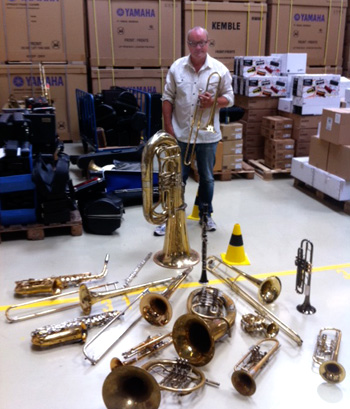
Nils Landgren Funk For Life
Funk For Life© returns to Kibera
Two years after the launch of the Funk For Life project in September 2009, the team is going back to Kibera (Nairobi, Kenya) in November 2011. Created & initiated by Swedish Jazz artists Nils Landgren & Magnum Coltrane Price, and supported by National Geographic Photographer Mattias Klum & Peter Östlund film-maker, and former General Director of the Swedish section of Doctors Without Borders, Dan Sermand.
The project aims to raise public awareness about the acute and basic needs in the urban slums and has been endlessly advocated over the past two years in various media and in front of public audiences all around the world.
Striving for more than a year to return to Kibera, the team once more generously supported by Yamaha (instruments), AIR FRANCE KLM (transport) & Médecins Sans Frontières (logistics), will proceed with its second trip on the ground to perform a second musical instruments distribution to music schools in the slums of Kibera and musical workshops to sensitise and teach the kids about these music schools.
This second trip will also aim to finalise a movie/documentary about the Funk For Life project, which started in 2009. The documentary focuses on the living conditions of the population of the slum of Kibera and the role that Médecins Sans Frontières/Doctors Without Borders plays in providing free access to health care in their clinics inside the slums.
——————————————————-
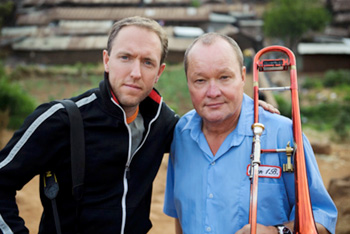
Mattias Klum & Nils Landgren
Description of the project
Funk for Life© is a project aimed at raising the public awareness about the acute and basic needs in the urban slums. The idea behind Funk For Life© was formulated and hatched by Nils Landgren & Magnum Coltrane Price (Jazz Artists) and Mattias Klum (National Geographic film maker and photographer) and is supported by MSF Sweden and AIR FRANCE – KLM, which have provided communication and logistical support from Stockholm & Nairobi.
Nils landgren & Magnum Coltrane Price, famous and talented musicans and composers have long had a passionate interest in humanitarian aid work. Consequently, Nils Landgren & Magnum Coltrane Price were involved with MSF Sweden (Läkare Utan Gränser) for almost as long as MSF Sweden has been in existence (first time in 1996). During the Being a Hero Is Easy Concert, commemorating MSF Swedens 15-year anniversary, Nils Landgren & Magnum Coltrane Price were some of the headliners. This connection between Nils Landgren, Magnum Coltrane Price and MSF Sweden, coupled with their burning interest for music and humanitarian aid, has contributed to Nils and Magnum’s continued support and cooperation with MSF Sweden.
In the past, Nils has been involved in projects dedicated to providing instruments and musical education instruction to children in the slums in South Africa and Brazil. Beginning of 2009, Nils Landgren contacted MSF-Sweden with an idea for a project. As in Brazil and South Africa, the project involves traveling to slums, distributing musical instruments, and providing musical education/sensitisation. As this journey will be done in relation to the release of Nils Landgrens band (Nils Landgren Funk Unit) latest album, a special concert will also be held specifically for the population that Nils want to support in his project. In conjunction with the project, the Nils Landgren Funk Unit has pledged a portion of the proceeds from the sale of their album (Funk for Life) to MSF.
This project has been highly interactive with the local population, while allowing documentation by Mattias Klum to provide the public in other parts of the world with a look into the realities of urban slums and the potential and advancements of humanitarian work done by MSF.
Location
MSF-Sweden, together with MSF Operational Center Brussels, believed that the most suitable place to realize the project was the slums of Kibera in Kenyas capital, Nairobi.
Kibera has an estimated population of approximately half a million. Covering an area of 2.5 square kilometers, Kibera has a population density of approximately 2000 inhabitants per hectare, and is effectively one of Africas largest slums. It is estimated that the HIV prevalence in Kibera is between 10-13% (HIV prevalence estimates 2008: Global 0.8%; Sub-Saharan Africa 5.5%; Kenya 7%.)
The high prevalence of HIV infections makes MSFs choice of allocating the money to the HIV/AIDS project in Kenya particularly suitable.
Despite the high population density, very few public investments are made in Kibera, leading to severe lacks in clean water, electricity, sanitation, education and healthcare.
In cooperation conjunction with the Ministry of Public Health and Sanitation, MSFOCB currently runs three health structures in different villages in the Kibera slum. The Funk For Life© project would complement MSF advancements by providing interactive activities for the children, generating funds for the MSF HIV/AIDS project in Kenya, and raising public awareness about the precarious health conditions in slums and MSFs advancements in the face within the landscape of such widespread difficulties.


